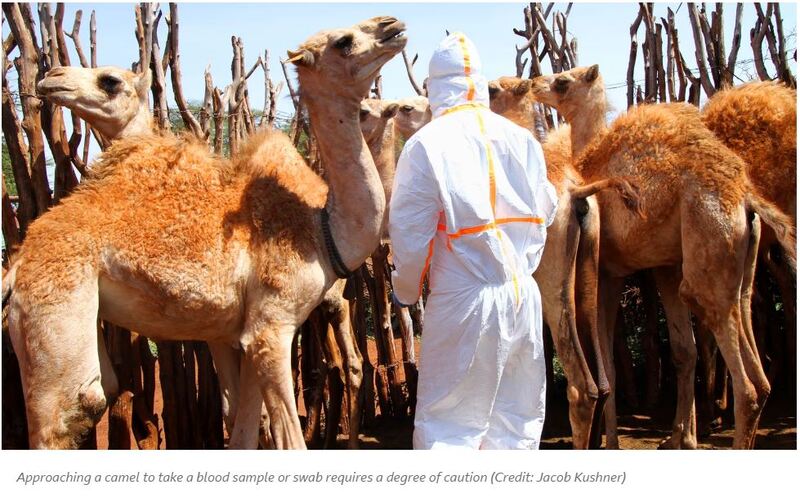Item
Why camels are worrying coronavirus hunters
Title (Dublin Core)
Why camels are worrying coronavirus hunters
Description (Dublin Core)
In northern Kenya, researchers are working to prevent a dangerous coronavirus – Mers – from jumping from camels to humans again. But climate change is making their job more difficult.
I
It’s thought that Covid-19 originated in animals before jumping to humans. Now experts are warning that the chances are the next pandemic will, too.
Seventy-five percent of the newly emerging diseases currently affecting people originate in animals, according to Predict, a US government-funded collaboration by infectious disease experts across the globe. Already, Predict scientists have identified 1,200 new zoonotic, or animal-borne, diseases. But scientists estimate there are some 700,000 more zoonotic diseases we don’t even know about yet.
...
“That infection” is Middle East respiratory syndrome (Mers), a novel coronavirus that so far has proven to be at least 10 times more deadly than Covid-19. It was discovered in Saudi Arabia in 2012. By 2016, the World Health Organization (WHO) had identified “1,761 laboratory-confirmed cases of infection with Mers-CoV, including at least 629 related deaths”.
Later that year, an outbreak at a hospital raised the alarm that it’s not just camel herders who are susceptible to the disease, but anyone at all.
But while camels can be carriers, the Mers threat to humans is mostly man-made. As human-induced climate change makes droughts more frequent, prolonged, and severe, herders have had to abandon cows and other livestock for camels because only they can survive weeks without water. The result is a growing number of camels in close contact with humans – the perfect conditions for the spread of a deadly disease.
Mers causes the same sorts of respiratory system complications as Covid-19, including pneumonia. Symptoms often start with nasal congestion, a cough, chest pains, or difficulty breathing. In the worst cases, it may cause fibrosis – irreversible scarring – in the lungs. This can be deadly. More than one-third of all humans known to have contracted Mers have died from it, according to the WHO.
Once it jumps from animals to humans, a Mers outbreak could grow rapidly. Saudi Arabia alone saw 15 people infected in December 2019 and January 2020 – three of whom were hospital workers infected by their patients. “The fact that RNA viruses such as coronaviruses mutate means you never know what could happen with that particular virus,” says Zimmerman.
I
It’s thought that Covid-19 originated in animals before jumping to humans. Now experts are warning that the chances are the next pandemic will, too.
Seventy-five percent of the newly emerging diseases currently affecting people originate in animals, according to Predict, a US government-funded collaboration by infectious disease experts across the globe. Already, Predict scientists have identified 1,200 new zoonotic, or animal-borne, diseases. But scientists estimate there are some 700,000 more zoonotic diseases we don’t even know about yet.
...
“That infection” is Middle East respiratory syndrome (Mers), a novel coronavirus that so far has proven to be at least 10 times more deadly than Covid-19. It was discovered in Saudi Arabia in 2012. By 2016, the World Health Organization (WHO) had identified “1,761 laboratory-confirmed cases of infection with Mers-CoV, including at least 629 related deaths”.
Later that year, an outbreak at a hospital raised the alarm that it’s not just camel herders who are susceptible to the disease, but anyone at all.
But while camels can be carriers, the Mers threat to humans is mostly man-made. As human-induced climate change makes droughts more frequent, prolonged, and severe, herders have had to abandon cows and other livestock for camels because only they can survive weeks without water. The result is a growing number of camels in close contact with humans – the perfect conditions for the spread of a deadly disease.
Mers causes the same sorts of respiratory system complications as Covid-19, including pneumonia. Symptoms often start with nasal congestion, a cough, chest pains, or difficulty breathing. In the worst cases, it may cause fibrosis – irreversible scarring – in the lungs. This can be deadly. More than one-third of all humans known to have contracted Mers have died from it, according to the WHO.
Once it jumps from animals to humans, a Mers outbreak could grow rapidly. Saudi Arabia alone saw 15 people infected in December 2019 and January 2020 – three of whom were hospital workers infected by their patients. “The fact that RNA viruses such as coronaviruses mutate means you never know what could happen with that particular virus,” says Zimmerman.
Date (Dublin Core)
Creator (Dublin Core)
Contributor (Dublin Core)
Type (Dublin Core)
news article
Link (Bibliographic Ontology)
Controlled Vocabulary (Dublin Core)
Contributor's Tags (a true folksonomy) (Friend of a Friend)
Collection (Dublin Core)
Exhibit (Dublin Core)
Pandemic Pets>Our Wild Animal Friends
Date Submitted (Dublin Core)
08/14/2021
Date Modified (Dublin Core)
08/15/2021
09/23/2021
Date Created (Dublin Core)
01/25/2021
Item sets
This item was submitted on August 14, 2021 by Ashley Tibollo using the form “Share Your Story” on the site “A Journal of the Plague Year”: http://mail.covid-19archive.org/s/archive
Click here to view the collected data.New Tags




















